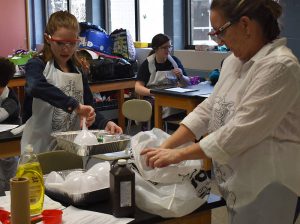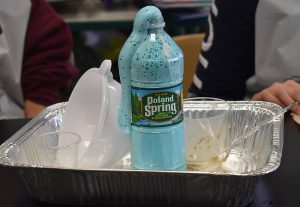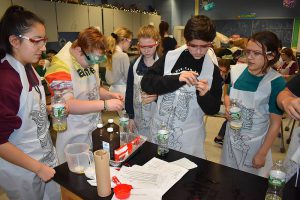Do you know what an exothermic reaction is?
 Students in Amy Sicina’s seventh-grade science classes do, and they used every day home products as part of a recent lab class called “Elephant’s Toothpaste” to show how energy can be released through light or heat.
Students in Amy Sicina’s seventh-grade science classes do, and they used every day home products as part of a recent lab class called “Elephant’s Toothpaste” to show how energy can be released through light or heat.
An exothermic reaction is a chemical reaction that releases energy through light or heat. The chemical equation is: reactants → products + energy. Exothermic gets its name from a Greek word which is literally translated to “out,” meaning “releases”; and “thermic,” which means heat.
“The demonstration is part of the STEM (science-technology-engineering-mathematics) activities in our curriculum,” said Mrs. Sicina. “Students will study and relate the chemical, physiological and biological effects of combining hydrogen peroxide and yeast to produce an exothermic reaction in a colorful and fun demonstration.”
In this instance, students used products found in many kitchens to demonstrate the reaction.
“Cooking is a part of everyday life and by using products found in the kitchen, students can demonstrate and explain how an exothermic reaction can be produced,” she added.
Elephant toothpaste?
 But, where does “elephant’s toothpaste” come into play?
But, where does “elephant’s toothpaste” come into play?
For this experiment, students used a plastic water bottle, hydrogen peroxide, liquid dish soap, food coloring, a package of dry yeast and measuring spoons along with a funnel and lab safety gear to make toothpaste big enough in scale for…. well…. an elephant to use.
First, they added four ounces of 40-volume hydrogen peroxide to a one-liter soda bottle.
Then, they added a squirt of dish soap and some food coloring to the hydrogen peroxide in the bottle and gave the solution a quick, gentle swirl to mix the contents.
After that, they mixed two teaspoons dry yeast with four tablespoons of very warm water in a small plastic cup and stirred the mixture with a spoon. If the mixture was too thick or paste-like, they added a small amount of warm water to thin it out.
Once that was done, they poured the yeast mixture into the bottle and watched what happened.
Within seconds, the mixture reacted to ooze out of the one-liter bottle and looked like…you guessed it…toothpaste which was “large” enough to use for brushing an elephant’s teeth.
Yeast makes it happen
 The yeast worked as a catalyst to release the oxygen molecules from the hydrogen peroxide solution. The oxygen-filled bubbles, which make up the foam, are actually the remainder of what happens when the hydrogen peroxide breaks down into water and oxygen. The bottle felt warm to the touch because this was an exothermic reaction in which energy is given off in the form of heat.
The yeast worked as a catalyst to release the oxygen molecules from the hydrogen peroxide solution. The oxygen-filled bubbles, which make up the foam, are actually the remainder of what happens when the hydrogen peroxide breaks down into water and oxygen. The bottle felt warm to the touch because this was an exothermic reaction in which energy is given off in the form of heat.
“It was very cool to watch it ‘foam’ out of the bottle,” said student Olivia Loeven. “Yeast can make substances expand.”
Her classmate Logan Morales wished the toothpaste-like substance “foamed” more.
“It’s fun to see the aftermath,” he added. “She (Mrs. Sicina) was very creative in how she used products from a kitchen to be used in science to make the explosion happen.”
In future extensions of this experiment, students will further their understanding of the “M” of STEM by calculating the various equations to explain the chemical reactions that take place when the materials are combined, Mrs. Sicina added. Students will be expected to explore the “T” and the “E” of STEM to design modifications of the experiment to test different and/or expected outcomes of results.
See more photos on the district’s Facebook page.
